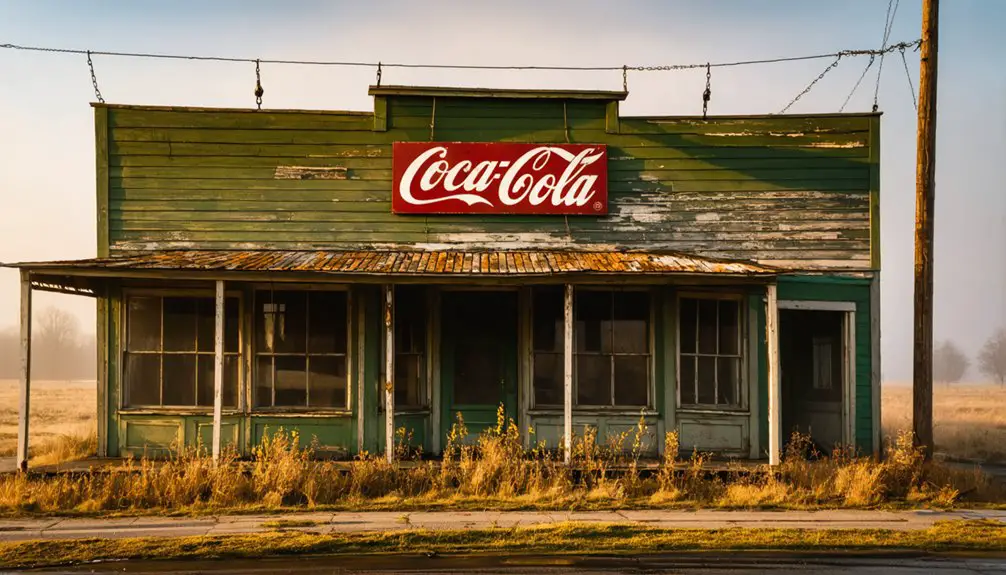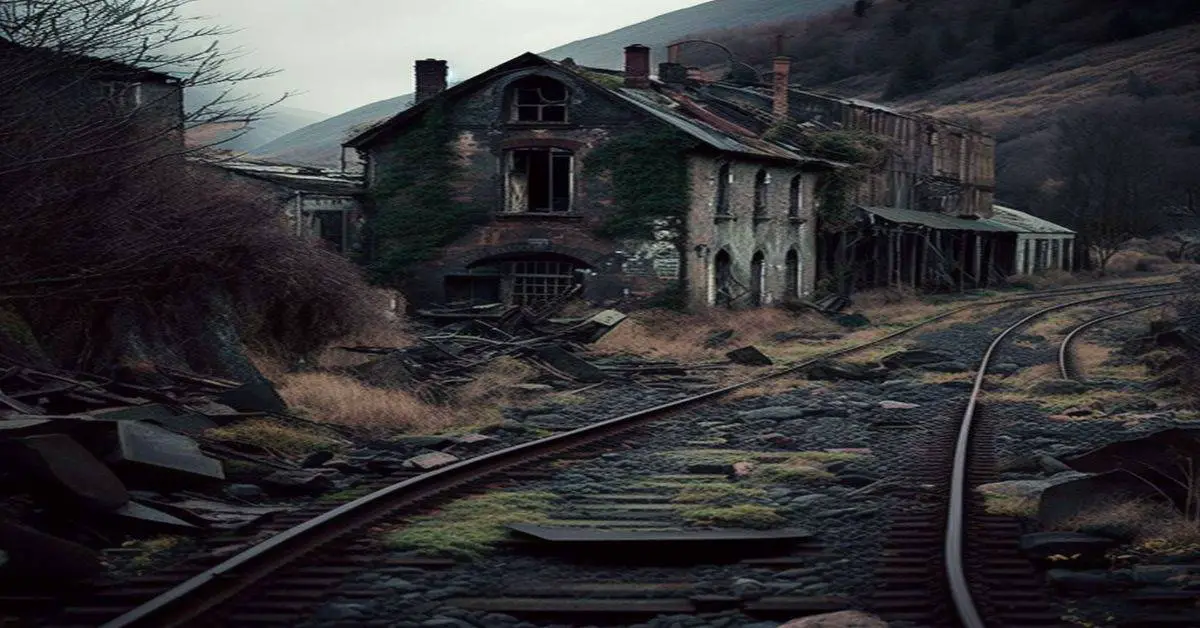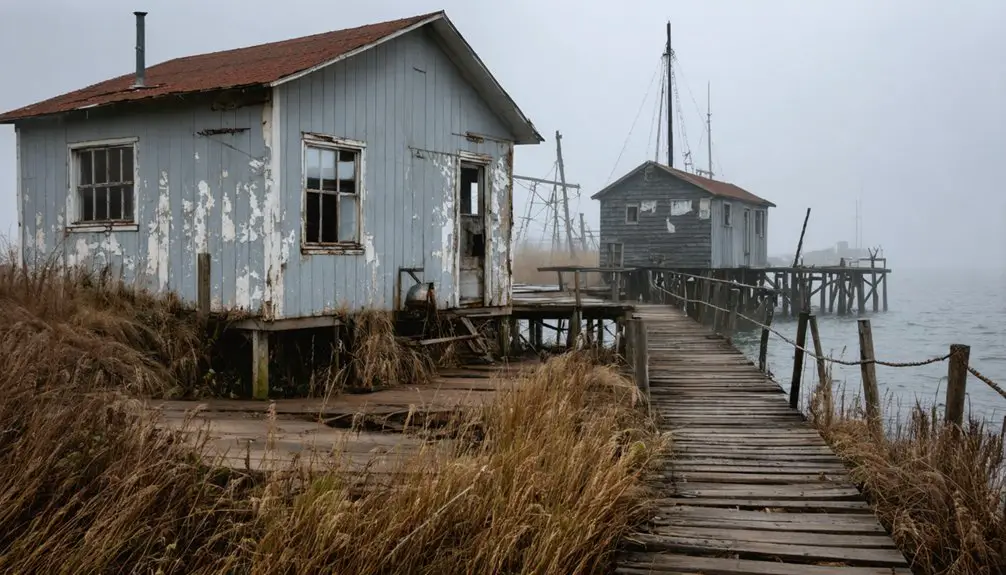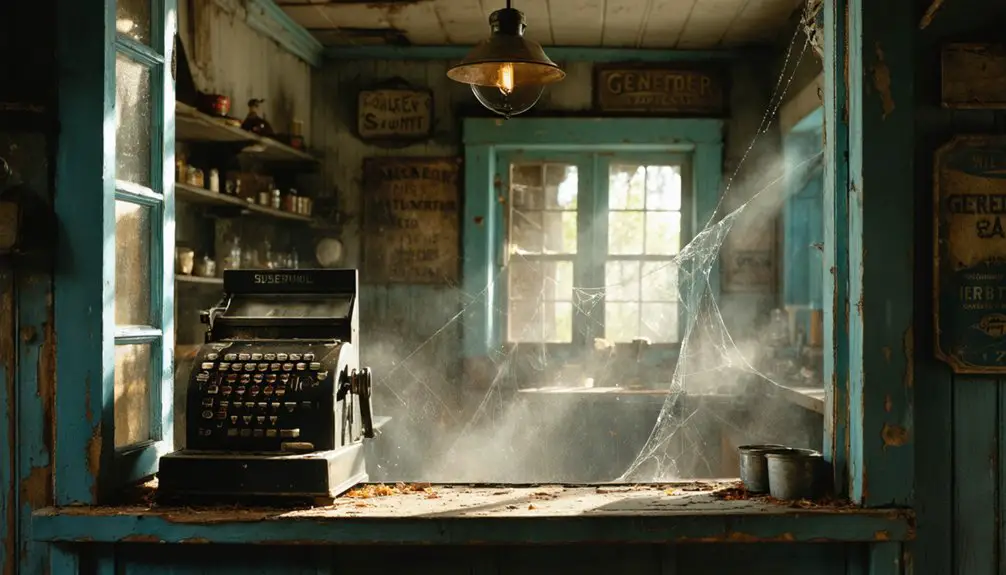You’ll find Worden’s ghost town remnants hidden beneath Wisconsin’s wilderness, where a bustling lumber boomtown once flourished in 1893. The town thrived on white pine harvesting and initially attracted settlers seeking timber wealth, but its fortunes changed when the Eau Claire Lumber Company depleted local resources. Without an essential railroad connection, residents gradually abandoned their homes. Today, scattered foundation stones and building footings tell silent stories of this vanished community’s past.
Key Takeaways
- Worden, Wisconsin was established in 1893 as a lumber boomtown but declined after the Eau Claire Lumber Company depleted local timber resources.
- The town’s lack of railroad connection contributed significantly to its abandonment as residents moved away to more connected areas.
- Today, only scattered foundation stones and building footings remain, largely hidden beneath natural overgrowth and vegetation.
- Worden’s decline mirrors many Wisconsin lumber towns that flourished during the white pine logging era and later became ghost towns.
- Visitors to the former town site face challenging terrain and seasonal weather conditions while exploring the remnants.
The Rise of a Lumber Empire
When the Menominee Nation ceded vast portions of central and eastern Wisconsin to the United States in 1836, they unknowingly set the stage for one of America’s greatest lumber empires.
The long winter camps became home to thousands of lumberjacks who worked tirelessly in the harsh conditions.
By 1866, timber near all waterways had been completely harvested, forcing companies to explore deeper into the forests.
You would’ve witnessed an explosion of lumber production along Wisconsin’s rivers, where sawmills sprouted up, powered by rushing waterfalls.
Towns like Stevens Point and Wausau grew around these crucial centers of industry.
Life at the Grand Plank Hotel
As you stepped into the Grand Plank Hotel‘s magnificent lobby, you’d have encountered a masterpiece of early 20th-century architecture, where an imposing brick fireplace dominated the space and Frank Lloyd Wright-inspired art-glass skylights cast dancing patterns across the floor.
Your guest experiences would’ve included modern luxuries rare for the era: electrical lighting throughout, elevator service, and private baths in select rooms. The hotel’s innovative amenities included thermostat controls in every room, a feature pioneered by luxury establishments of the time.
You might’ve rubbed shoulders with Chicago banking tycoons in the adjacent saloon or attended one of the many political gatherings featuring luminaries like William Jennings Bryan. The hotel’s design drew inspiration from the architectural style of Frank Lloyd Wright, much like other prestigious properties of the period.
The hotel’s architectural influences reflected the ambition of its time, with fireproof construction and ornate leaded windows setting new standards for regional hospitality.
In the bustling dining room, you’d have joined the town’s social elite, making decisions that shaped the community’s future.
Railroad’s Role in Worden’s Success
Through the ambitious expansion of the Wisconsin Central Railroad in 1870, Worden transformed from a remote wilderness into a thriving commercial hub. You’d have witnessed how the railroad’s 250-mile track from Menasha to Ashland revolutionized the region’s economic landscape.
The railroad expansion brought unprecedented prosperity to Worden. You could’ve loaded your lumber onto freight cars bound for Chicago or St. Paul, while the sawmills flourished with efficient transportation at their doorstep. The company’s promise of free government land for each mile of track laid further accelerated development in the area. Local communities like Worden contributed to the effort, as towns provided funding for right of way and roadbed preparation.
The economic impact rippled through the community as settlers flocked to the area, drawn by the promise of market access and supply lines. Despite financial challenges, including a massive 1,600-foot bridge over the White River, the railroad’s presence guaranteed Worden’s connection to civilization and commerce, forever changing the settlement patterns of northern Wisconsin.
From Boom Town to Ghost Town
The once-bustling township of Worden exemplified the classic American boomtown story, beginning with its official establishment by the Clark County Board on May 13, 1893.
The abundant white pine forests nurtured by ancient glaciers made the area a prime logging destination.
You’d have witnessed typical boomtown dynamics as settlers flocked to the area, drawn by the promise of timber wealth and agricultural opportunities.
Early settlers faced immense challenges as they worked to clear the wild forest and construct basic log houses.
Like many ghost town stories, Worden’s decline came as swiftly as its rise. When the Eau Claire Lumber Company depleted the region’s timber, the township’s economic foundation crumbled.
Without a railroad connection to sustain growth, residents gradually moved to more prosperous towns. Nature slowly reclaimed the land, with springtime flora now dancing where bustling streets once stood.
Today, you’ll find only scattered remnants of buildings hidden in the woodlands, silent witnesses to the freedom-seeking pioneers who once called Worden home.
Exploring Worden’s Remains Today
Modern explorers seeking Worden’s remains will encounter a challenging landscape where nature has steadily consumed most traces of this once-vibrant township.
You’ll find only scattered foundation stones and possible building footings beneath the overgrowth of central Wisconsin’s forests and fields.
Similar to other Wisconsin communities, the town’s decline was influenced by changes in rail routes.
Site accessibility depends heavily on weather conditions, with spring mud and winter snow potentially limiting your adventure.
Be mindful of seasonal challenges when planning your visit – muddy spring thaws and deep winter snows can make exploration difficult.
You’ll need proper preparation: sturdy footwear, navigation tools, and possibly landowner permissions to explore the area.
Similar to mysterious Doveland’s status, no official maps mark Worden’s exact location today.
Don’t expect tourist amenities or interpretive signs – this is raw ghost town exploration at its purest.
As you navigate through the vegetation-covered site, you might discover old fencing or rusted artifacts, but they’re sparse.
Document what you find through photos, as these remnants face ongoing natural degradation without active preservation efforts.
Frequently Asked Questions
Were Any Famous Outlaws or Historical Figures Known to Visit Worden?
You won’t find any famous outlaws or historical figures who visited this place – historical records don’t show evidence of notable personalities passing through, keeping the town’s past quietly mysterious.
What Native American Tribes Originally Inhabited the Area Before Worden’s Establishment?
Like ancient footprints in time, you’ll find the Ho-Chunk people were primary inhabitants, while Menominee heritage shaped the region’s northern reaches. Both tribes called this sacred land home before settlement.
Did Any Major Fires or Natural Disasters Contribute to Worden’s Decline?
You won’t find evidence of fire impact or disaster effects destroying this settlement. Historical records don’t indicate any major catastrophes contributed to the town’s decline – it likely faded from economic causes.
Are There Any Surviving Photographs of Worden During Its Peak Years?
You won’t find confirmed historical records or photographic evidence of this town’s peak period, though unexamined local archives and family collections might still hold undiscovered images waiting to be found.
What Happened to the Families Who Stayed After the Logging Industry Collapsed?
Like stubborn roots clinging to rocky soil, you’d find these families faced economic struggles but showed remarkable community resilience, attempting farming on depleted land while adapting to tourism and seasonal work opportunities.
References
- https://hauntedhouses.com/washington/fort-worden-guard-house/
- https://hauntedhouses.com/washington/ft-worden-commanding-officers-quarters-museum/
- https://lakecountrytribune.com/exploring-the-haunting-echoes-of-wisconsins-ghost-towns/
- https://www.youtube.com/watch?v=AydgS5_IgDY
- https://en.wikipedia.org/wiki/List_of_ghost_towns_in_Wisconsin
- https://www.wisconsinhistory.org/Records/Article/CS409
- https://npshistory.com/publications/usfs/region/9/nicolet/history/chap2.htm
- https://mywisconsinwoods.org/2022/09/30/looking-back-at-the-history-of-wisconsin-forests/
- https://wi101.wisc.edu/online-exhibit/the-lumber-industry-in-northern-wisconsin-exhibit/
- https://wi101.wisc.edu/the-lumber-industry-in-northern-wisconsin/



